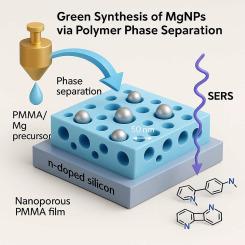Unleashing the potential of magnesium nanoparticles: A green synthesis for sustainable sensing solutions
IF 9.2
2区 工程技术
Q1 ENERGY & FUELS
引用次数: 0
Abstract
For the first time, we unveil an innovative, one-step approach for synthesizing magnesium nanoparticles (MgNPs), combining efficiency, simplicity, and environmental sustainability. Our method utilizes spin-coating of a magnesium precursor-loaded poly(methyl methacrylate) (PMMA) dispersion onto n-doped silicon substrates. This process induces vapor-driven phase separation, leading to the self-assembly of PMMA into a nanoporous film that encapsulates MgNPs within its nanoholes. Unlike traditional methods that depend on toxic reducing agents or complex synthesis routes, our approach eliminates the need for additional stabilizers, making it a greener and more efficient alternative for nanostructure fabrication. By systematically optimizing precursor concentration and spin-coating speed, we precisely control the size and dispersity of MgNPs, achieving spherical nanoparticles of approximately 50 nm − the smallest size reported to date. Optical characterization using micro-extinction spectroscopy confirms the presence of localized surface plasmon resonance (LSPR) in the Mg/PMMA composite, demonstrating its potential for advanced sensing applications. X-ray photoelectron spectroscopy (XPS) reveals that MgNPs are passivated by a native MgO layer, enhancing stability and minimizing oxidation under ambient conditions. These substrates exhibit outstanding surface-enhanced Raman scattering (SERS) sensitivity, detecting 4,4′-bipyridine (4,4′-BP) at low concentrations. This innovative strategy offers a sustainable path for developing earth abundant plasmonic nanomaterials with tunable optical properties.

释放镁纳米颗粒的潜力:可持续传感解决方案的绿色合成
我们首次推出了一种创新的一步合成镁纳米颗粒(MgNPs)的方法,结合了效率,简单性和环境可持续性。我们的方法利用旋转涂层的镁前驱体负载聚甲基丙烯酸甲酯(PMMA)分散到n掺杂的硅衬底。该过程诱导气相分离,导致PMMA自组装成纳米孔膜,将MgNPs封装在其纳米孔内。与依赖于有毒还原剂或复杂合成路线的传统方法不同,我们的方法不需要额外的稳定剂,使其成为更环保、更高效的纳米结构制造替代方案。通过系统地优化前驱体浓度和旋转包覆速度,我们精确地控制了MgNPs的尺寸和分散性,获得了大约50纳米的球形纳米颗粒,这是迄今为止报道的最小尺寸。使用微消光光谱的光学表征证实了Mg/PMMA复合材料中存在局部表面等离子体共振(LSPR),显示了其在高级传感应用中的潜力。x射线光电子能谱(XPS)表明,MgNPs被原生MgO层钝化,增强了稳定性,并在环境条件下最大限度地减少了氧化。这些底物表现出出色的表面增强拉曼散射(SERS)灵敏度,可以检测低浓度的4,4 ' -联吡啶(4,4 ' -BP)。这一创新策略为开发具有可调谐光学特性的地球丰度等离子体纳米材料提供了一条可持续的途径。
本文章由计算机程序翻译,如有差异,请以英文原文为准。
求助全文
约1分钟内获得全文
求助全文
来源期刊

Sustainable Materials and Technologies
Energy-Renewable Energy, Sustainability and the Environment
CiteScore
13.40
自引率
4.20%
发文量
158
审稿时长
45 days
期刊介绍:
Sustainable Materials and Technologies (SM&T), an international, cross-disciplinary, fully open access journal published by Elsevier, focuses on original full-length research articles and reviews. It covers applied or fundamental science of nano-, micro-, meso-, and macro-scale aspects of materials and technologies for sustainable development. SM&T gives special attention to contributions that bridge the knowledge gap between materials and system designs.
 求助内容:
求助内容: 应助结果提醒方式:
应助结果提醒方式:


